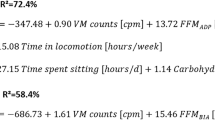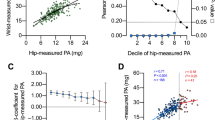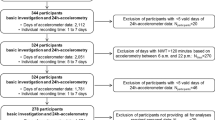Abstract
OBJECTIVE: The movement of the upper limbs (eg fidgeting-like activities) is a meaningful component of nonexercise activity thermogenesis (NEAT). This study examined the relationship between upper limb movements and whole body trunk movements, by simultaneously measuring energy expenditure during the course of the day.
DESIGN: A cross-sectional study consisting of 88 subjects with a wide range in body mass index (17.3–32.5 kg/m2). The energy expenditure over a 24-h period was measured in a large respiratory chamber. The body movements were assessed by two uniaxial-accelerometers during daytime, one on the waist and the other on the dominant arm. The accelerometry scores from level 0 (=immobile) up to level 9 (=maximal intensity) were recorded. The activities of subjects were classified into eight categories: walking at two speeds on a horizontal treadmill (A & B), ambling (C), self-care tasks (D), desk work (E), meals (F), reading (G), watching TV (H).
RESULTS: There was a significant relationship between the accelerometry scores from the waist (ACwaist) and that from the wrist (ACwrist) over the daytime period (R2=0.64; P<0.001). The ACwrist was systematically higher than the ACwaist during sedentary activities, whereas it was the reverse for walking activities. ACwrist to ACwaist ratio of activities E–H were above 1.0 and for walking activities (A–C) were below 1.0. A multiple regression analysis for predicting daytime energy expenditure revealed that the explained variance improved by 2% only when the ACwrist was added as a second predictor in addition to the ACwaist. This indicates that the effect of the ACwrist for predicting energy expenditure was of limited importance in our conditions of measurement.
CONCLUSIONS: The acceleration of the upper limbs which includes fidgeting is more elevated than that of the whole body for sitting/lying down activities. However, their contribution to energy expenditure is lower than whole body trunk movements, thus indicating that the weight-bearing locomotion activities may be a key component of NEAT. However, its contribution may depend on the total duration of the upper limb movements during the course of the day.
This is a preview of subscription content, access via your institution
Access options
Subscribe to this journal
Receive 12 print issues and online access
$259.00 per year
only $21.58 per issue
Buy this article
- Purchase on Springer Link
- Instant access to full article PDF
Prices may be subject to local taxes which are calculated during checkout


Similar content being viewed by others
References
Levine JA, Eberhardt NL, Jensen MD . Role of nonexercise activity thermogenesis in resistance to fat gain in humans. Science 1999; 283: 212–214.
Schutz Y, Weinsier S, Terrier P, Durrer D . A new accelerometric method to assess the daily walking practice. Int J Obes Relat Metab Disord 2002; 26: 111–118.
Coronado M, Janssens JP, de Muralt B, Terrier P, Schutz Y, Fitting JW . Walking activity measured by accelerometry during respiratory rehabilitation. J Cardiopulm Rehabil 2003; 23: 357–364.
Bouten CV, Westerterp KR, Verduin M, Janssen JD . Assessment of energy expenditure for physical activity using a triaxial accelerometer. Med Sci Sports Exerc 1994; 26: 1516–1523.
Zhang K, Werner P, Sun M, Pi-Sunyer FX, Boozer CN . Measurement of human daily physical activity. Obes Res 2003; 11: 33–40.
Uswatte G, Miltner WH, Foo B, Varma M, Moran S, Taub E . Objective measurement of functional upper-extremity movement using accelerometer recordings transformed with a threshold filter. Stroke 2000; 31: 662–667.
Bussmann JB, Martens WL, Tulen JH, Schasfoort FC, van den Berg-Emons HJ, Stam HJ . Measuring daily behavior using ambulatory accelerometry: the Activity Monitor. Behav Res Methods Instrum Comput 2001; 33: 349–356.
Schasfoort FC, Bussmann JB, Stam HJ . Ambulatory measurement of upper limb usage and mobility-related activities during normal daily life with an upper limb-activity monitor: a feasibility study. Med Biol Eng Comput 2002; 40: 173–182.
Kumahara H, Schutz Y, Ayabe M, Yoshioka M, Yoshitake Y, Shindo M, Ishii K, Tanaka H . The use of uniaxial accelerometry for the assessment of physical-activity-related energy expenditure: a validation study against whole-body indirect calorimetry. Br J Nutr 2004; 91: 235–243.
Jéquier E, Schutz Y . Long-term measurements of energy expenditure in humans using a respiration chamber. Am J Clin Nutr 1983; 38: 989–998.
Rafamantanantsoa HH, Ebine N, Yoshioka M, Higuchi H, Yoshitake Y, Tanaka H, Saitoh S, Jones PJH . Validation of three alternative methods of measuring total energy expenditure against the doubly labeled water method in older Japanese men. J Nutr Sci Vitaminol 2002; 48: 517–523.
Higuchi H, Ayabe M, Shindo M, Yoshitake Y, Tanaka H . Comparison of daily energy expenditure in young and older Japanese using pedometer with accelerometer. Jpn J Phys Fitness Sports Med 2003; 52: 111–118 (In Japanese with English abstract).
Tamura T, Fujimoto T, Sakaki H, Higashi Y, Yoshida T, Togawa T . A solid-state ambulatory physical activity monitor and its application to measuring daily activity of the elderly. J Med Eng Technol 1997; 21: 96–105.
Sugimoto A, Hara Y, Findley TW, Yoncmoto K . A useful method for measuring daily physical activity by a three-direction monitor. Scand J Rehabil Med 1997; 29: 37–42.
Levine JA, Schleusner SJ, Jensen MD . Energy expenditure of nonexercise activity. Am J Clin Nutr 2000; 72: 1451–1454.
Levine J, Baukol P, Pavlidis I . The energy expended in chewing gum. N Engl J Med 1999; 341: 2100.
Webster JD, Welsh G, Pacy P, Garrow JS . Description of a human direct calorimeter, with a note on the energy cost of clerical work. Br J Nutr 1986; 55: 1–6.
Schutz Y . Rôle de l'inactivité physique dans l'étiologie de l'obésité. The role of physical inactivity in the etiology of obesity. Ther Umsch 1989; 46: 281–290 (In French).
Bussmann JB, Hartgerink I, van der Woude LH, Stam HJ . Measuring physical strain during ambulation with accelerometry. Med Sci Sports Exerc 2000; 32: 1462–1471.
Patterson SM, Krantz DS, Montgomery LC, Deuster PA, Hedges SM, Nebel LE . Automated physical activity monitoring: validation and comparison with physiological and self-report measures. Psychophysiology 1993; 30: 296–305.
Swartz AM, Strath SJ, Bassett Jr DR, O'Brien WL, King GA, Ainsworth BE . Estimation of energy expenditure using CSA accelerometers at hip and wrist sites. Med Sci Sports Exerc 2000; 32: S450–S456.
Taub E, Crago JE, Uswatte G . Constraint-induced movement therapy: a new approach to treatment in physical rehabilitation. Rehabil Psychol 1998; 43: 152–170.
Kumahara H, Tanaka H, Schutz Y . Estimation of upper limb movements using dual accelerometry in a confinement situation (Abstract). Int J Obes Relat Metab Disord 2003; 27: S36.
Redmond DP, Hegge FW . Observations on the design and specifications of a wrist-worn human activity monitoring system. Behav Res Methods Instrum Comput 1985; 17: 659–669.
Herren R, Sparti A, Aminian K, Schutz Y . The prediction of speed and incline in outdoor running in humans using accelerometry. Med Sci Sports Exerc 1999; 31: 1053–1059.
Acknowledgements
This work was in part supported by the Medical Frontier Strategy Research Grants H13-21th-31 from Japanese Ministry of Health Labor and Welfare.
We are grateful to the participants for their cooperation. We thank the Japanese associations/groups in Switzerland, particularly The Japan Club of Geneva, The Swiss–Japanese Journal Grüezi and The Swiss Happy Net (http://www.swippy.ch), and the people who helped in the recruiting process of the subjects. We are grateful to Assistant Professor Takuya Yahiro and the staff at the Laboratory of Exercise Physiology, Faculty of Sports and Health Science, Fukuoka University for their valuable assistance in making the preparations for this study. We would also like to acknowledge the contribution of Professor Munehiro Shindo at the Fukuoka University; Professor Yutaka Yoshitake, PhD, at the National Institute of Fitness and Sports in Kanoya; Mayumi Yoshioka, PhD, at the Laval University Medical Center and Laval University and thank them for their support.
A part of this study was presented at 12th European Congress on Obesity in Helsinki, Finland (ECO2003).23
Author information
Authors and Affiliations
Corresponding author
Rights and permissions
About this article
Cite this article
Kumahara, H., Tanaka, H. & Schutz, Y. Daily physical activity assessment: what is the importance of upper limb movements vs whole body movements?. Int J Obes 28, 1105–1110 (2004). https://doi.org/10.1038/sj.ijo.0802712
Received:
Revised:
Accepted:
Published:
Issue Date:
DOI: https://doi.org/10.1038/sj.ijo.0802712
Keywords
This article is cited by
-
Quantified assessment of hyperactivity in ADHD youth using IR-UWB radar
Scientific Reports (2021)
-
A systematic literature review of reviews on techniques for physical activity measurement in adults: a DEDIPAC study
International Journal of Behavioral Nutrition and Physical Activity (2018)
-
The validity of the non-exercise activity thermogenesis questionnaire evaluated by objectively measured daily physical activity by the triaxial accelerometer
BMC Sports Science, Medicine and Rehabilitation (2014)
-
Are pedometers adequate instruments for assessing energy expenditure?
European Journal of Clinical Nutrition (2009)
-
The contribution of upper limb and total body movement to adolescents’ energy expenditure whilst playing Nintendo Wii
European Journal of Applied Physiology (2008)



